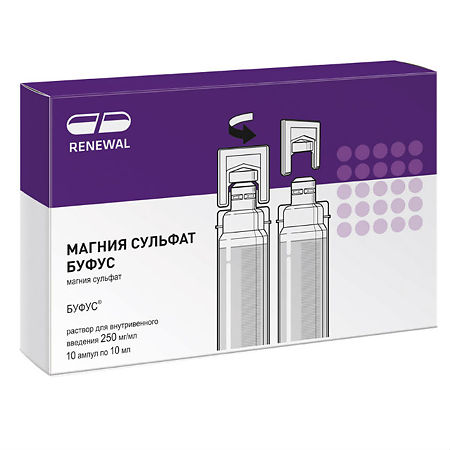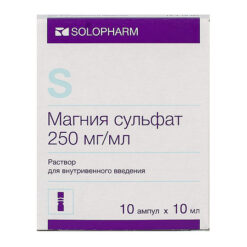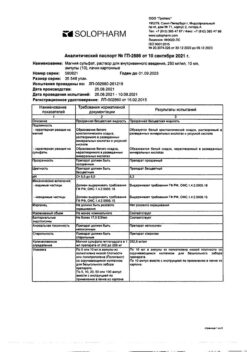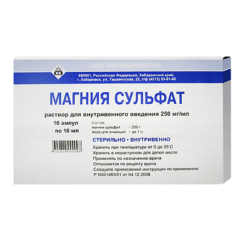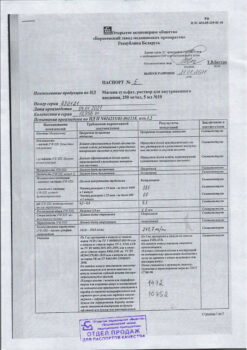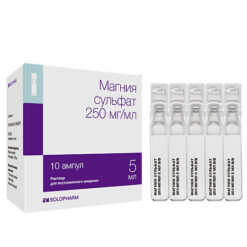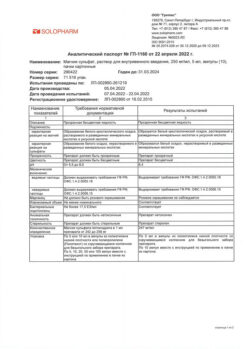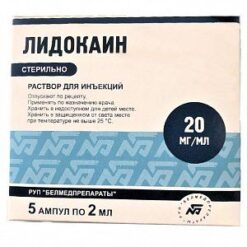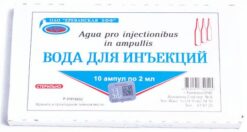No products in the cart.
Magnesium sulfate bufus, 250 mg/mL 10 ml 10 pcs
€2.04 €1.00
EAN: 4603988016399
SKU: 334566
Categories: Anesthesia and resuscitation, Anesthesia solutions, Medicine
Description
Pharmacotherapeutic group: vasodilator.
The ATX code: B05XA05
Pharmacological properties
Pharmacodynamics
When administered parenterally it has anticonvulsant, antiarrhythmic, hypotensive, antispasmodic effect, inhibits neuromuscular transmission in high doses, has tonic effect, inhibits respiratory center.
Magnesium is a “physiological” calcium antagonist (by blocking “slow” calcium channels) and can displace it from binding sites. It regulates metabolic processes, inter-neuronal transmission and muscle excitability, prevents the entry of calcium ions through the presynaptic membrane, reduces the amount of acetylcholine in the peripheral nervous system and central nervous system (CNS), which leads to inhibition of neuromuscular transmission.
Relaxes the smooth muscle of the internal organs, uterus and blood vessels, reduces blood pressure (mostly elevated), increases diuresis.
Anticonvulsant effect. Magnesium reduces the release of acetylcholine from neuromuscular synapses, thus suppressing neuromuscular transmission, has a direct inhibitory effect on the CNS.
The antiarrhythmic action. Magnesium reduces excitability of cardiomyocytes, restores ionic balance, stabilizes cell membranes, disrupts sodium current, slow incoming calcium current and unilateral potassium current.
Tocolytic action. Magnesium inhibits contractility of myometrium (by reducing absorption, binding and distribution of calcium ions in smooth muscle cells), increases blood flow in the uterus as a result of expansion of its vessels. It is an antidote for poisoning by salts of heavy metals.
The systemic effects develop almost immediately after intravenous administration.
The duration of action when administered intravenously is 30 minutes.
Pharmacokinetics
The equilibrium concentration (Css) is 2-3.5 mmol/L. Penetrates through the blood-brain and placental barriers. Breast milk produces concentrations 2 times higher than blood plasma concentrations. Excretion is by the kidneys; the rate of renal excretion is proportional to plasma concentrations and glomerular filtration rate.
Indications
Indications
– Arterial hypertension (including hypertensive crisis with cerebral edema phenomena);
– polymorphic ventricular tachycardia (pirouette type);
– eclampsia (to suppress seizures) and preeclampsia (to prevent seizures in severe preeclampsia);
– uterine tetany;
Active ingredient
Active ingredient
Composition
Composition
Active ingredient:
Magnesium sulfate heptahydrate – 250 mg
Auxiliary substances:
Sodium hydroxide – to pH 5.5-8.0
[1 M sodium hydroxide solution]
water for injection – to 1 ml
How to take, the dosage
How to take, the dosage
Intravenously (slow trickle or drip). The patient should be in the supine position.
Doses are adjusted for therapeutic effect and serum magnesium ion concentrations.
Hypertensive crisis. Intravenously (slowly over about 5 minutes) 5-20 ml of magnesium sulfate solution 250 mg/ml.
Polymorphic ventricular tachycardia. Administer intravenously 1-2 g (4-8 ml of drug) for about 5 minutes, repeated administration is possible.
Preeclampsia and eclampsia. The dose is set individually depending on the clinical situation. The saturation dose is 2-4 g (8-16 ml of drug) in 5-20 minutes (infusion). Maintenance dose – 1-2 g (4-8 ml of the drug) per hour.
Tetany uterus. The saturation dose is 4 g (16 ml of the drug) after 20 minutes (infusion). Maintenance dose – 1-2 g (4-8 ml of drug) per hour at first, later 1 g (4 ml of drug) per hour (can be administered by drip 24-72 hours).
Hypomagnesemia.
In newborns. The daily dose is 0.2-0.8 mg/kg intravenously slowly.
In adults:
Mild: magnesium sulfate solution is used parenterally if the oral route of magnesium administration is impossible or impractical (due to nausea, vomiting, impaired resorption in the stomach, etc.). The daily dose is 1-2 g (4-8 ml of the drug). This dose is administered once or in 2-3 doses;
Severe: the initial dose – 5 g (20 ml of the drug) intravenously slowly in 1 liter of infusion solution (0.9% sodium chloride solution or 5% dextrose (glucose) solution). The dose is adjusted depending on the concentration of magnesium ions in blood serum.
Prevention of hypomagnesemia in patients receiving parenteral nutrition only.
If the nutrient solutions do not contain magnesium, it is added additionally. The daily dose is 1.5-4 g. Usually 1 g of magnesium sulfate is added to 1 liter of parenteral nutrition solution. The maximum daily dose of magnesium sulfate for adults is 40 g.
The doses of magnesium sulfate given above are given in grams and correspond to the amount of 250 mg/ml solution: 1 g – 4 ml; 2 g – 8 ml; 3 g – 12 ml; 4 g – 16 ml; 5 g – 20 ml; 10 g – 40 ml; 15 g – 60 ml; 20 g – 80 ml; 30 g – 120 ml; 40 g – 160 ml.
Magnesium sulfate solution is diluted with injectable solutions: 0.9% sodium chloride or 5% dextrose (glucose).
In long-term use it is recommended to monitor blood pressure, heart activity, tendon reflexes, renal activity, respiratory rate.
If simultaneous administration of calcium and magnesium salts is necessary, the drugs should be administered in different veins.
Interaction
Interaction
Patients who use other drugs together with magnesium sulfate should inform their physician.
Magnesium sulfate increases the effect of other drugs that depress the central nervous system.
The cardiac glycosides increase the risk of conduction disorders and atrioventricular block (especially when concomitant intravenous administration of calcium salts).
Myorelaxants and nifedipine increase neuromuscular blockade.
When combined use of magnesium sulfate for parenteral administration with other vasodilators may increase the hypotensive effect.
Barbiturates, narcotic analgesics, hypotensive drugs increase the likelihood of respiratory center depression. Disrupts absorption of tetracycline group antibiotics, weakens the effect of streptomycin and tobramycin. Calcium salts reduce the effect of magnesium sulfate.
. Pharmaceutically incompatible (forms precipitate) with calcium preparations, ethanol (in high concentrations), carbonates, hydrocarbonates and phosphates of alkali metals, clindamycin phosphate, salts of arsenic acid, barium, strontium, hydrocortisone sodium succinate, polymyxin B sulfate, procaine (novocaine) hydrochloride, salicylates and tartrates.
Special Instructions
Special Instructions
Magnesium sulfate should be used cautiously so that toxic concentrations of the drug do not occur. Elderly patients should usually use a reduced dose because they have reduced renal function.
Patients with impaired renal function (if creatinine clearance is greater than 20 mL/min) and oliguria should not receive more than 20 g of magnesium sulfate (81 mmol Mg2+) for 48 hours and should not administer magnesium sulfate intravenously too rapidly. Monitoring of serum concentration of magnesium ions (should be no higher than 0.8-1.2 mmol/l), diuresis (at least 100 ml/h), respiratory rate (at least 16/min), blood pressure is recommended, control of tendon reflexes is necessary.
If magnesium sulfate is administered, a calcium solution, such as 10% calcium gluconate solution, should be available for intravenous administration.
The use of magnesium sulfate can distort the results of radiological studies for which technetium is used.
Impact on the ability to drive vehicles, mechanisms
Contraindications
Contraindications
Hypersensitivity to the drug; severe arterial hypotension, respiratory center depression, severe bradycardia, grade I-III atrioventricular block (AV blockade); severe chronic renal failure (creatinine clearance less than 20 ml/min); prenatal period (2 hours before delivery); conditions associated with calcium deficiency.
With caution
Side effects
Side effects
Slow respiratory rate, dyspnea; acute circulatory failure; weakened reflexes; hyperemia; marked decrease in blood pressure; hypothermia; weakened muscle tone; uterine atony; hyperhidrosis; anxiety; marked sedation; polyuria; decreased heart rate; electrocardiogram changes.
The drug decreases excitability of the respiratory center; large doses of the drug when administered parenterally can easily cause paralysis of the respiratory center.
The early signs and symptoms of hypermagnesemia are: bradycardia, diplopia, sudden “rush” of blood to the face, headache, decreased blood pressure, nausea, shortness of breath, blurred speech, vomiting, asthenia.
Overdose
Overdose
Symptoms
The disappearance of the knee reflex, nausea, vomiting, a sharp decrease in blood pressure, bradycardia, respiratory depression and central nervous system activity.
Treatment
Pregnancy use
Pregnancy use
The use of the drug during pregnancy and during breastfeeding is possible only by prescription if the expected benefits to the mother exceed the potential risk to the fetus or the baby.
The use of the drug is contraindicated in the prenatal period (2 hours before labor).
Magnesium sulfate penetrates into the breast milk, so if it is necessary to use the drug during lactation, breastfeeding should be stopped.
Similarities
Similarities
Additional information
| Shelf life | 3 years. |
|---|---|
| Conditions of storage | In the package at a temperature not exceeding 25 ° C. Keep out of reach of children. |
| Manufacturer | Update PFC AO, Russia |
| Medication form | solution |
| Brand | Update PFC AO |
Other forms…
Related products
Buy Magnesium sulfate bufus, 250 mg/mL 10 ml 10 pcs with delivery to USA, UK, Europe and over 120 other countries.

